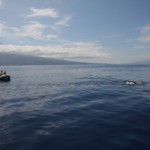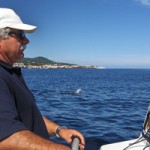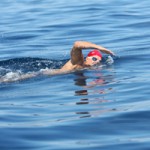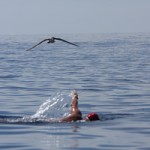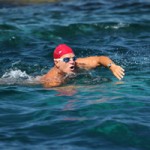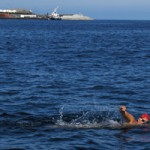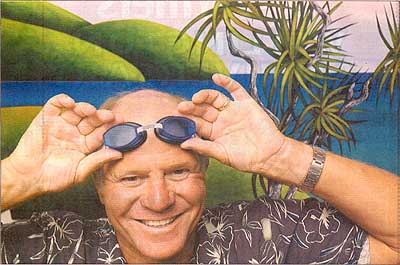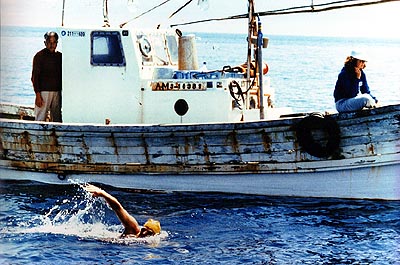Telo Island to Sigata Island, North Sumatra, Indonesia
October 14, 2011
Telo Island to Sigata Island, North Sumatra, Indonesia
3 hours, 36 minutes – First Person


North Sumatra, Indonesia 2011
October 9, 2011
Sipika Island to Simaleko Island, North Sumatra, Indonesia
3 hours, 59 minutes – First Person


Madeira Islands from Ihla Madeira to Ihla Desertas Grande
September 26, 2010
Factos: David Yudovin: Um arrojado nadador de canais, entre tubarões e baleias
Treino, concentração e persistência. São estes os segredos de David Yudovin para as suas travessias de muitas horas nos canais marítimos de todo o mundo.
David Yudovin é um norte-americano da Califórnia que se tornou conhecido em diversas partes do mundo como nadador de canais. Tem conseguido atravessar com sucesso diversos mares, em vários continentes. É uma actividade que faz com prazer. Corre riscos, com ponderação. As decisões, de quando deve partir ou nadar, são suas. Por isso recusa apoios comerciais. No seu currículo contam-se as travessias do Canal da Mancha, o Estreito de Gibraltar, o Estreito de Cook na Nova Zelândia, o Estreito de Sunda na Indonésia, o Estreito de Tsugaru no Japão, entre outros. Agora acrescentou a travessia da ilha da Madeira para as ilhas Desertas, efectuada no início deste mês.

David no Faial onde fez o primeiro canal em Portugal.
Com 60 anos de idade tem um currículo invejável e as suas maratonas marítimas são todas planeadas ao pormenor, com a ajuda da mulher, Mary Beth, que desde há 25 anos é a sua treinadora, acompanhando-o em todos os percursos. “É ela que sabe tudo sobre mim, que sabe o que eu preciso para me manter em forma e para ter as condições necessárias para uma maior concentração e melhor esforço”, disse-nos o simpático nadador que passou três semanas na nossa ilha. Além de Mary Beth, David fez-se acompanhar nesta viagem à Madeira pelo seu piloto, o açoriano Altino Goulart, que conheceu no Faial, em 2008, onde fez três travessias entre as ilhas do arquipélago vizinho. “É um homem que sabe muito de mar, que foi um óptimo auxiliar, pois nestas travessias é preciso navegador, é preciso alguém que conheça e nos indique o melhor percurso, depois é uma questão de concentração para cumprir o objectivo”, explicou-nos o norte-americano.
O nadador referiu-nos que a travessia entre a Madeira e as Desertas apresentava-se como um desafio interessante, já que este canal é muito afectado por correntes e ventos, que, por vezes, passam e sopram de formas imprevisíveis. Disse-nos que não há um segredo especial para o seu sucesso. É tudo resultado da disciplina e da concentração para minimizar o ‘stress’, pois o nadador não deve estar preocupado com coisas desnecessárias nos dias anteriores da travessia. Revelou-nos que sempre foi um homem de causas. Quando jovem, a par do desporto – da natação é óbvio – tocou guitarra e seguiu com muita ponderação o negócio da família. Hoje está reformado, com mais tempo para o seu ‘hobby’ de eleição, com uma forma física e atlética invejáveis. Pronto para novas travessias… não obstante um grande susto que passou, quando uma vez na Indonésia, em que sofreu um ataque cardíaco e esteve durante cerca de uma hora com o coração parado. Todos o julgavam morto, mas a verdade é que ‘ressuscitou’ e continuou a nadar como antes.
Na entrevista que nos concedeu, no Reid’s Palace, onde esteve hospedado na Madeira, fez questão em salientar que o seu equipamento para as travessias, algumas delas de mais de 12 horas, são os calções de banho, uma touca e uns óculos. Segue a legislação desportiva dos EUA que não permite fatos impermeáveis, nem barbatanas.

Calção, touca e óculos é este o equipamento que
David Yudovin necessita para as suas maratonas no mar.A concentração é a chave do seu sucesso. Mesmo nalgumas ocasiões em que teve de nadar entre tubarões e outros animais marinhos de maior dimensão. Até na travessia para as Desertas encontrou duas baleias, enormes, pareciam orcas. Mas, recorda: “Esses animais estão no seu meio, nós é que somos os intrusos, somos os seus convidados e devemos respeitá-los. Sempre passei entre eles sem qualquer percalço.”
David Yudovin é neto de russos, que emigraram para os Estados Unidos, há muitos anos. Dedicaram-se à comercialização de pescado na Califórnia. Um negócio
que está nas mãos da família desde há muitas décadas. David foi administrador de três empresas internacionais ligadas ao sector, com os irmãos e os sobrinhos. Como não tem filhos, o seu ramo de sucessão dará lugar aos sobrinhos.Em 2008 David Yudovin realizou as primeiras travessias de canais marítimos em Portugal. As três entre ilhas do arquipélago dos Açores. Primeiro foi Faial-Pico, em 2h20, depois Pico-São Jorge em 7h26 e fechou com Corvo-Flores, em 7h10.
Desde há dois anos que não nadava uma travessia. Como todas as que tem feito até agora, são preparadas com antecipação, com um trabalho de levantamento minucioso, em que é importante o conhecimento dos mares e das zonas em que irá nadar, os meios de acompanhamento disponíveis e as facilidades de socorro instaladas. Todos esses pormenores concorrem para o sucesso de cada evento, em que a boa preparação física e emocional do atleta é o ponto fulcral.
David conta que nunca voltou para trás nas suas travessias. E deve isso à sua preparação, ao trabalho árduo a que se obriga todos os dias, para estar em forma e aos apoios em terra e no mar que ele próprio coordena e dirige antes de qualquer travessia. Como não tem intenções competitivas, não aceita patrocínios comerciais, e os objectivos são pessoais e traçados como metas individuais. A mulher é que trata da sua preparação física e a tudo o que possa contribuir para um melhor desempenho do atleta, desde os treinos em ginásio até às piscinas. Durante a estadia na Madeira, no Reid’s Palace, onde permaneceram três semanas, o casal nadava diariamente uma hora nas águas límpidas da baía do Funchal, junto do hotel.

David e Mary fotografados no Hotel Reid’s Palace.
A lista de canais que David pretende fazer ainda é considerável. Inclui o Mediterrâneo, a Ásia e o Sul do Pacífico. E admite que Portugal é uma hipótese forte, porque gostou bastante de cá estar e pensa voltar. Não tem planos para qualquer canal em particular.
Quando resolveu nadar na Madeira, David Yudovin fez o reconhecimento do percurso, trouxe o seu navegador Altino Goulart, que é da ilha do Faial, nos Açores, um marinheiro “com muita experiência no mar”.

Numa das travessias junto do barco de apoio.
Desta primeira experiência na Madeira leva as melhores recordações: “É uma ilha absolutamente maravilhosa, a primeira vez que coloquei a cara na água fiquei maravilhado, não podia acreditar neste azul transparente das águas dos seus mares”, observou-nos.
Sem dúvida que irá recomendar a Madeira aos seus amigos. Vai continuar a nadar, a divulgar a ilha que o acolheu este Verão, pois acha que se parece muito com diversas localidades de praia que conhece na Califórnia: sossegada, virada para o mar e muito verde.
Quanto ao futuro respondeu-nos que vai estudar alguns locais para decidir a sua próxima travessia. Mas, certo, é de que irá continuar sem apoios comerciais ou institucionais, porque “é muito perigoso estar dependente de compromissos publicitários”. Se aceitasse perderia autonomia e poder de decisão. “Se eu tivesse um ‘sponsor’ a decisão seria de acordo com os compromissos assumidos. Pago tudo e tenho o controlo completo da minha actividade”, explica.



Original Article:
www.dnoticias.pt/impressa/revista/228310/228323-factos-david-yudovin-um-arrojado-nadador-de-canais-entre-tubaroes-e-b
Corvo Flores Channel, Azores from Corvo Island to Flores Island 2008
David Yudovin, um veterano atleta norte-americano, completou, ao início da noite da passada sexta-feira, a travessia a nado entre as ilhas do Corvo e das Flores.
O experiente nadador da Califórnia, de 58 anos de idade, demorou sete horas e 10 minutos a percorrer as cerca de 10 milhas náuticas que separam as duas ilhas do Grupo Ocidental dos Açores.
Com recurso apenas a uma touca e a uns óculos, David Yudovin lançou-se ao mar para mais esta aventura, no lugar do Boqueirão, na mais pequena ilha do arquipélago, pelas 12:57 horas, cerca de quatro horas depois da hora inicialmente prevista, devido às más condições climatéricas que se faziam sentir.

David Yudovin, um veterano atleta norte-americano, completou, ao início da noite da passada sexta-feira, a travessia a nado entre as ilhas do Corvo e das Flores.
O experiente nadador da Califórnia, de 58 anos de idade, demorou sete horas e 10 minutos a percorrer as cerca de 10 milhas náuticas que separam as duas ilhas do Grupo Ocidental dos Açores.
Com recurso apenas a uma touca e a uns óculos, David Yudovin lançou-se ao mar para mais esta aventura, no lugar do Boqueirão, na mais pequena ilha do arquipélago, pelas 12:57 horas, cerca de quatro horas depois da hora inicialmente prevista, devido às más condições climatéricas que se faziam sentir.
Segundo Altino Goulart, um dos «skipper» do Clube Naval da Horta que acompanhou a aventura, a ondulação de três metros e o vento forte que se faziam sentir entre as Flores e o Corvo na manhã desse dia, altura prevista para o início da travessia, obrigaram David Yudovin e a sua equipa de apoio a adiar a partida.
As condições eram tão adversas que o barco que costuma fazer a ligação entre estas duas ilhas em 40/50 minutos, levou na sexta-feira cerca de 2 horas e completar o percurso.



David Yudovin, um veterano atleta norte-americano, completou, ao início da noite da passada sexta-feira, a travessia a nado entre as ilhas do Corvo e das Flores.
O experiente nadador da Califórnia, de 58 anos de idade, demorou sete horas e 10 minutos a percorrer as cerca de 10 milhas náuticas que separam as duas ilhas do Grupo Ocidental dos Açores.
Com recurso apenas a uma touca e a uns óculos, David Yudovin lançou-se ao mar para mais esta aventura, no lugar do Boqueirão, na mais pequena ilha do arquipélago, pelas 12:57 horas, cerca de quatro horas depois da hora inicialmente prevista, devido às más condições climatéricas que se faziam sentir.
Segundo Altino Goulart, um dos «skipper» do Clube Naval da Horta que acompanhou a aventura, a ondulação de três metros e o vento forte que se faziam sentir entre as Flores e o Corvo na manhã desse dia, altura prevista para o início da travessia, obrigaram David Yudovin e a sua equipa de apoio a adiar a partida.
As condições eram tão adversas que o barco que costuma fazer a ligação entre estas duas ilhas em 40/50 minutos, levou na sexta-feira cerca de 2 horas e completar o percurso.
«Entretanto, o vento diminuiu, a ondulação desceu para 1,5 metros e ficámos com uma janela de oito a 10 horas de bom tempo», recordou Altino Goulart, acrescentando que o nadador norte-americano aproveitou a oportunidade para se lançar à água, embora estivesse ciente de que a prova poderia ser interrompida a qualquer altura, por razões de segurança.

Segundo explicou, durante a travessia as correntes marítimas não estavam muito fortes, «à excepção de uma zona, exactamente, a meio do percurso», o que acabou por facilitar também a tarefa do veterano atleta, que chegou à freguesia de Ponta Delgada, nas Flores, pelas 19:07 horas, local onde era esperado por várias dezenas de pessoas.
Esta é a terceira aventura do género que David Yudovin realiza nos Açores em menos de um mês, depois de em Agosto ter batido o recorde da travessia a nado entre as ilhas do Faial e o Pico (cerca de cinco milhas náuticas), percurso que completou em duas horas e 20 minutos, e de há quinze dias, ter batido também o recorde da travessia a nado entre o Pico e São Jorge (cerca de 10 milhas), com um tempo de sete horas e 27 minutos.
A mulher de David, Beth Yudovin, também acompanhou as suas aventuras, seguindo a bordo de uma das embarcações de apoio, uma das quais transportava também um enfermeiro para prestar auxílio durante a travessia em caso de necessidade.
Esta iniciativa contou com o apoio da Polícia Marítima de Santa Cruz das Flores, que andou no mar com uma embarcação e dos Bombeiros Voluntários de Santa Cruz das Flores e do Corvo.A próxima «aventura» de David Yudovin já está marcada para 2009, em Cabo Verde, provavelmente com a mesma equipa de apoio.


Faial Pico Channel, Azores from Faial Island to Pico Island
August 20, 2008
Faial Pico Channel, Azores from Faial Island to Pico Island





Pico S. Jorge Channel
Cook Strait, New Zealand
January 19, 2004
Cook Strait Swimmer’s Final Goal
Kim Ruscoe
The Dominion PostHEART attack survivor David Yudovin has ticked off his last swimming challenge, becoming the oldest man to swim Cook Strait.
The 52-year-old American’s heart stopped beating during a marathon swim near Ventura, California, in 1978, when he was 27. He fought his way backto health and went on to rack up a list of conquests, which include becoming the first and only person to swim from Santa Cruz Island to the California coast in 1983, and the English Channel in 1996.
On Friday he added Cook Strait to his list, swimming it in 9 hours and 38 minutes.
His swim puts him in the record books for being the oldest person to make the crossing. The previous oldest swimmer was 42.
“I’m very proud of it,” Mr. Yudovin said.
But there were times during the crossing when he thought he would have to give up – not to mention the jellyfish stings.
“When the wind came up, I thought if this gets any worse, I’m not going to be able to make it,” he said.
“Then I’d hit cold points and it would take the air out of me.”
Hypothermia was a real issue for Mr. Yudovin, for it was extreme cold that caused his heart attack 25 years ago.
Having spent more than a year preparing and training for his latest swim, Mr. Yudovin and his wife Beth, arrived in the Bay of Islands in November to gear up and moved down to Wellington this month.
“We rented a house in Wellington for three months, three days later we got the weather window we were looking for and the decision was made to go for it.”
Mr. Yudovin’s four-man crew was led by former endurance swimmer and Hall of Fame member Philip Rush.
“He was absolutely fabulous,” Mr. Yudovin said.
“He was in an inflatable boat next to me the whole time.”
As to what comes next, Mr. Yudovin is unsure.
“This was the last swim on my wish-list.”
“It’s a very, very strenuous sport on the body. I have to start getting realistic about my body.”
For now he is content to bask in his latest triumph and enjoy New Zealand as a tourist before heading back to the United States to run his seafood businesses.
Sunda Strait, Indonesia
July 15, 2000
Not the easiest way to Sumatra
22-mile trip through terrifying waters wraps up year of achievements
Kathe Tanner
The Tribune
David Yudovin of Cambria dodged vicious whirlpools and endured “thousands of jellyfish stings” for more than 10 hours to become the first human to swim across Sunda Strait in Indonesia.
The approximately 22-mile swim was a watershed event for Yudovin. It was a second try at the potentially deadly endeavor and “was the culmination of all my skills,” Yudovin said, “from swimming and sailing to business skills of inspiring people to work together and develop personal relationships.”

Back home on the North Coast, David Yudovin towels off after a swim Friday afternoon north of the San Simeon Pier. photo: Robert Dyer The swim between Java and Sumatra wraps up quite a year for Yudovin. In May, the athlete, who holds five other world records, was inducted into the Marathon Swimmers’ Hall of Fame in Ft. Lauderdale, Fla., joining an honor roll of only about 130 other swimmers from around the world.
For his latest marathon swim, Yudovin was in the Sunda Strait from 4:01 a.m. July 8 to 2:25 p.m., in basically calm seas. He left from Pujut Beach (northwest of Jakarta on the northwest end of Java) and arrived “on the only stretch of beach to land on” – a narrow patch of sand surrounded by jungle north of Kanggalan in Sumatra.
While Yudovin swam, a native guide with a hand-held compass (who stood in the bow of the primary escort boat for the entire trip) relayed course corrections to the Javanese captain, said Yudovin’s wife and co-captain Beth Yudovin.
From a previous attempt at the swim in April 1997, the couple knew the risks. “It’s a hellaciously dangerous swim,” David said earlier this year, “with potentially deadly tidal currents and vicious whirlpools, huge brown, bulbous jellyfish with long, long tentacles along with highly poisonous sea snakes and crocodiles.
“The whirlpools were awful,” he said. “The fishermen had told me ‘If you get caught in a whirlpool, you are not coming back up again.’
“It’s as dangerous an adventure as anyone could go on. I was sure I was going to die. It was like a washing machine. It took me six months to recover.”
David Yudovin knows the hazards of marathon swimming. In 1978, while finishing a marathon near Ventura, Yudovin suffered a near-fatal heart attack.
Fortunately, the latest attempt in Indonesia was both successful and not nearly as hazard-laced as his first try.
Besides the risks, David and Beth also had to tackle language barriers between Bahasa and English, cultural and religious differences, chokingly thick smog and smoke, and the logistical difficulties of launching such an endeavor from half a world away.
“This was no cookie-cutter channel swim,” he said, such as the classical swim across the English Channel, which he completed in 1996.
In the end, none of those differences in Indonesia mattered, David said. “It was working together to achieve a goal, a microcosm of international diplomacy.
“I wanted this swim so much, and they wanted it just as badly as I did. That’s what made it happen.”
All it took to turn the native fishermen’s emotional tide was watching David’s first workout in the water, Beth said. At that point, the natives converted from being employees (who desperately needed the money) to wholehearted cheerleaders.
Hours after returning home to Cambria on Thursday, the swimmer still was awash in the emotional impact of what they’d accomplished and how that feat had touched others’ lives.
“This was magic,” he said. “We are absolutely, totally flying high.”
David repeatedly gulped back tears as he recounted the superstitious, mistrusting Muslim fishermen who helped coordinate the event and later escorted the swimmer and his wife on the swim.
“These fishermen are very heavily religious and spiritual. They believe in ghosts and spirits,” the swimmer said. Before the Javanese would participate, “they even wanted me to go meet a powerful magic man.”
Beth explained, “After David’s beach workout, they marched us a mile and a half over hill and dale through the jungle to a dirt hut, where the magic man was sitting on a floor, smoking a cigarette.”
David said, “The magic man said, ‘I can’t make you swim any better, but I can make the weather better.’ ”
Afterward, the natives joined the spiritual leader in elaborate ceremonies to pray for good conditions.
The alliance between the successful business couple and 11 Third-World poor fishermen and three native boats worked incredibly well, David said. “I had the technical knowledge, the charts and tide tables, the high-tech equipment like my GPS (global positioning system equipment) and the ability to use them all. They had their traditional fishermen’s knowledge and lifelong experience with the water, the currents and the weather.”
In the end, native knowledge won out.
The day before the swim, all the electronic gadgetry indicated conditions that would have caused the Yudovin’s to scrub the mission. But “the fishermen said ‘when the sun rises, the wind will die,’ and it did. It went flat,” said David.
“They knew the nuances of currents and weather that our books and equipment don’t show. We believed them. And it worked.”
But nothing about this swim was normal, the Yudovin’s recalled. Even at the end, David said, “I swam parallel to the jungle and forest for about three-quarters of a mile, about a half-mile out. I said to myself, ‘I just hope there’s no horrible things in the water out here.’”
Because of a long, shallow ocean shelf, Yudovin had to jog across coral, rocks and sand to get to the beach. And, once the onshore celebrating was over, he had to throw the boat’s rope over his shoulder and tow it past the sandbar to get it back into open water so everybody could go back to Java again.
“I was the only one strong enough to do it,” a laughing Yudovin said. “It was a surrealistic end to an incredible swim.”

The English Channel, UK
August 31, 1996
England to France
Distance swimmer finishes 20 year trip across English Channel
Kathe Tanner
Special to the Telegram-TribuneAs long-distance swimmer David Yudovin climbed into the 64-degree English water before dawn, he was trying to complete a journey that began nearly 20 years ago.
In 1978, he’d fought his way back to health after a near-fatal heart attack 250 yards from the end of a marathon swim near Ventura. He’d trained and done other landmark swims. And now the 45-year-old Cambria resident and Los Angeles businessman was about to tackle swimming the English Channel.
Yudovin was ready; he’d had years of swimming experience and a rigorous monthlong pre-swim training schedule in Dover, England. He had his fierce desire, his official reservations from the channel swimming association and the approved gear for a sanctioned channel swim. Calling it gear may be stretching the point.
The only things between Yudovin and the always cold water and treacherous weather were a non-insulated swimsuit, goggles, earplugs and a heavy swim cap. The odds against a successful swim across the channel are certainly daunting. Even Yudovin, who had tried the swim three other times, acknowledged with a shrug and a grin that he can’t explain the lure of that 21-plus-mile stretch of icy water.
The channel is often laced with sewage, oil slicks, aquatic creatures (including stinging jellyfish), clinging seaweed and up to 400 ships a day. But most of all, channel waters are a digit-numbing cold. Although the water is about 10 degrees warmer than the average temperature of Cambria, it is still a long way from tropical or even comfortable, especially without a wetsuit.
Still, for many the siren call from the channel is strong. In the more than 120 years since Capt. Matthew Webb became the first to make it across the channel (taking more than 21 hours to do it), more than 4,000 other hardy souls have tried the swim. Hardiness is only part of Yudovin’s story.
Sure, he celebrated his 20th anniversary of swimming the Catalina Channel by doing it again, and an hour and five minutes faster than before. He has done 32 miles on a paddleboard in seven hours, 41 minutes. He and his wife, Beth, have sailed their 36-foot Catalina sloop to Hawaii and other distant ports. He also likes to do the previously undone.
Earlier this year Yudovin became the first to complete the nearly 4.4-mile Java Strait swim through the warm but treacherous waters from Bali to Java. The May 14 swim took him just 96 minutes. As a Bali publication said, “Considering that the crossing in the ferry (including the wait) takes around two hours, this might set a new trend for travelers without baggage.”
And true grit figures in the equation. For a heart attack survivor to contemplate swimming the English Channel, Yudovin acknowledges, he has to be a little loony. On Aug. 20, weather reports indicated it was almost a now-or-never call in the reservation he made two years ago for this attempt. Several nasty-looking low-pressure cells were due to start whipping up coastal waters with rain and wind the next day, and long-range predictions were equally bleak. That morning, “the weather was very, very calm. Real nice, glassy conditions; “very settled’ as they say here,” Yudovin said. So, he swam.
In typical English weather fashion, the calm didn’t last long. About eight hours out, Yudovin said, the first of the low-pressure cells swooped down and started pelting him with rain, strong tidal flow and heavily choppy water. Despite the inhospitable conditions, “I swam real strong,” Yudovin reported in a telephone interview from England.
During the swim, he could eat only a special nutritional supplement and could touch neither the boat that escorted him nor anybody on board. More than 13 hours later, he’d done it. He’d beaten the channel that had haunted his dreams for so long.
That night, when he climbed out near Calais, France, Yudovin was cold and tired, but too elated to feel it, he said. Many of the residents of nearby fishing villages had rushed to the beach to greet and congratulate him, having seen him approaching the shore. “We’re just flying on a cloud,” Yudovin said.
As he said of a previous swimming success, “It’s so rewarding and so fulfilling it almost tickles inside.”
Now that he’s conquered the channel, the Yudovin’s plan to “really mellow our lives out for a while. We need to just sit back and enjoy it,” he said, obviously looking forward to having warmer feet and some months with no time tables.
Some who know him well say the break won’t last long. Yudovin already has ideas for a couple of other “never done-before” swims and his business, Ocean Crystal Seafoods, is booming. If a heart attack at 27 didn’t slow David Yudovin down, success certainly won’t.
Kathe Tanner is a reporter for The Cambrian.
Honchu Island to Hokkaido Island, Japan
NHK News Video Click Title to launch
July 19, 1990
Cambrian conquers Hokkaido-Honchu channel
DAVID YUDOVIN SWIMS INTO THE HISTORY BOOKS
Margot Smith
Staff Writer / The CambrianThere are no gold medals, no loving cups, and no elaborately inscribed certificates to laud David Yudovin’s all-time world record achievement on July 7.Yudovin’s swim across the Tsugaru Channel between Japan’s largest islands of Hokkaido and Honchu is a personal victory.
“This is a real happening, not just a swim. It’s never been done before,” says Yudovin, after arriving home in Cambria last week.
The swimmer spent most of last summer trying, but typhoon-whipped weather conditions kept him on the Japanese beach, he reports.
“This time, I was determined to wait as long as it took to do it. There’s a lot of weather going through there,” the almost 39-year-old explains, and it took five weeks for conditions to be right.
Departing from a remote fishing village at the north end of Hokkaido Island, he was piloted by a Japanese fisherman whose boat also held Yudovin’s wife, Beth, and his father, Sandy, also of Cambria.
In order to make the arrangements and train the fisherman in piloting, Yudovin had taught himself “some quick Japanese; enough to get by.”
It took him 11 hours, 55 minutes, and 40 seconds to traverse the 17-mile channel. He figures he swam a total of 26 miles, allowing for diversions caused by currents. With drifting, he believes he covered 40 miles of water.
A second boat, carrying television and newspaper reporters, followed his progress.
“The story was broadcast all over Japan,” Yudovin says, “but we were only able to obtain one newspaper in the little village where we stayed with a Japanese family.
“It was a very big event there,” he continues. “People were moved to tears. For generations, their music and poetry has been about that channel. It holds great importance for them.”
The date of the swim was also significant to the Japanese.
“It was really a neat day, seven-seven,” Yudovin tells. “It’s a mythical holiday – a day in Japan for dreams to come true.”
According to myth, princes and princesses are stars, and they come together on July 7.
“I was completely ignorant of that fact” when choosing the day for the swim, he adds, telling how people write wishes on paper, and many brought their papers to him, wishing him luck.
Yudovin financed the entire cost of the venture and the practice sessions himself. The third-generation owner of a wholesale seafood brokerage in Los Angeles, he says he keeps business strictly separate from his swimming activities.
Those activities have included other major swimming achievements. In 1982, he swam from Anacapa Island to Oxnard in nine hours, 27 minutes, and in 1983, from Santa Cruz Island to Oxnard in 15 hours, 15 minutes. In 1984, he crossed from the Mexican island of North Coronado to the mainland in Tijuana in a record six and half hours.
“I was in perfect condition then,” he says.
In 1976, he swam from Catalina Island to the mainland, and in 1986, breasted the waves in the other direction. In 1985, it was the Straits of Gibralter in nine hours, 30 minutes.
Though they were all tough challenges, Yudovin remembers that his first swim from Anacapa Island, when he suffered cardiac arrest, was the most frightening crossing.
The cardiac arrest lasted for more than an hour, during which he was administered last rites at a hospital. He said his family was told even if he lived, he would be a vegetable. But the same condition that caused the cardiac arrest placed his body in a kind of suspended animation, and he revived with his faculties intact, he said.
To stay in condition for this crossing, Yudovin trained in the San Simeon cove all last winter, with a couple of trips to Hawaii where he could endure long swims in warmer water. For the San Simeon practice sessions, he wore a wetsuit and propelled a fast, 12-foot lifeguard paddle board.
Yudovin’s first encounter with the water was at Tacaloma Nursery School in West Los Angeles where he grew up. At the age of 7, he made the YMCA swim team and has been training for the 32 years since.



